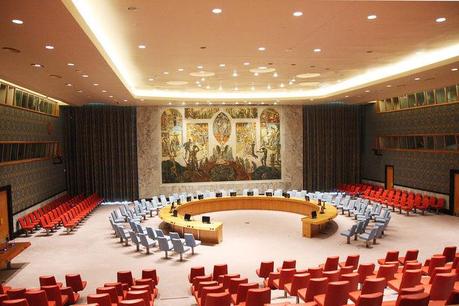
The United Nations Security Council Chamber, designed by the Norwegian architect Arnstein Arneberg and originally a gift of the Norwegian government, was painstakingly restored as part of a larger $2.1 billion overhaul of the U.N.'s New York campus.
Image courtesy of Royal Norwegian Consulate General New York.To visit the United Nations Security Council Chamber today, a little over a year since it was painstakingly restored as part of a larger $2.1 billion overhaul of the U.N.’s entire New York campus, is to see it as it appeared when it first opened in 1952.
That’s because the storied chamber—a gift from Norway designed by the architect Arnstein Arneberg—has been the beneficiary of a slavishly faithful renovation whose modern flourishes, including a new, highly efficient heating and cooling system, have been deftly hidden away so the revived period touches can shine.
The original chairs have been reupholstered in fresh Naugahyde, and decades of nicotine stains have been carefully scrubbed from the marble walls. The Damask wallpaper, designed by the Norwegian textile artist Else Poulsson, has been reproduced down to the tiniest detail. In fact, about the only visible difference is that the ashtrays that once separated the seats have been removed.
All of this is a reflection of the U.N.’s famously conservative culture and the impracticability of getting the five permanent members of the Security Council to agree on much of anything, to say nothing of the organization’s 193 member states.
“I was told quite clearly that architecture will not force reform, and that reform will happen when it’s going to happen, on its own time,” Michael Adlerstein, the assistant secretary general in charge of the renovation effort, told reporters who toured the renovated space on Wednesday. “So we put it all back together again the way it was.”
But that happened only after “we brought this room down to raw concrete,” he says, removing asbestos and lead. The renovation, which started in 2007, was supposed to take five years but ended up taking six, in part because of a car bomb that detonated outside the U.N. offices in Nigeria in 2011. Because the Conference building, which houses the Security Council chambers, cantilevers over the FDR Drive, security experts demanded that it be fortified with a thick platform of steel and concrete to protect it from particularly potent bomb blasts.
The visible changes may be largely cosmetic, but they are transformative in their way, brightening a space that had grown a little dark and dull with the passage of time. This is perhaps most noticeable on the signature mural by Per Krohg, a Norwegian artist who studied under Matisse. It shows a phoenix rising from the ashes of war, but some of the details in its darker bottom section—a pair of men playing cards in a cave, for example—had become almost completely obscured beneath layers of dirt and dust. A careful restoration has restored much of its original luster.
“We didn’t change very much,” Adlerstein says. “The Americans and the Russians and the Chinese are all extremely nervous about Security Council reform and the slippery slope—‘If you change this, where is that going to lead us?’
“And this works,” he says of the space. “Whether it works for the world is a matter of opinion, but it works for the five permanent members, so there’s a great deal of reluctance to change anything. They even refused to get rid of their 1950s leather blotters, which have sort of gone the way of using wet ink. They put their iPads on top, but they’re still using the same blotters.”
